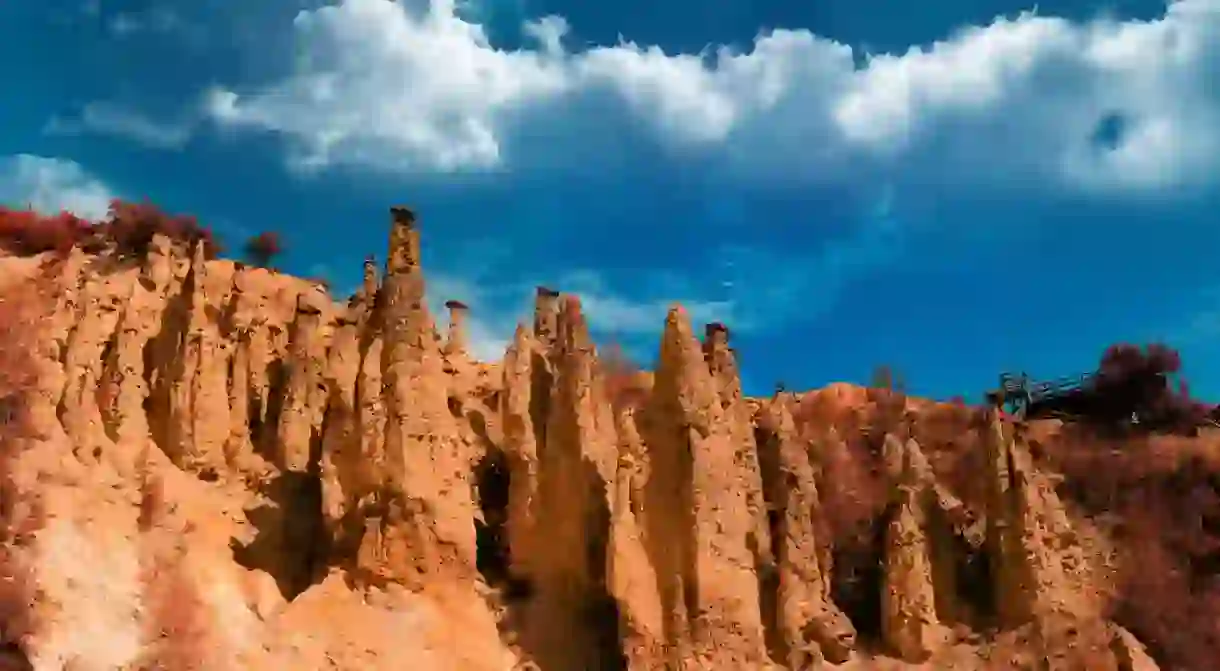Why You Need to Visit Southern Serbia

South Serbia is a vibrant land to say the least. You can find a little bit of everything here, from unusual natural formations to idyllic old towns, a unique cultural heritage and some of the best food on the planet. There are plenty of reasons to visit this hugely underrated part of Serbia.
Niš and its grisly history
There is no small amount of tragedy in the history of Serbia. Two of the nation’s most moving monuments to this history can be found in Niš. The grisly Skull Tower is one of the most famous Ottoman era constructions in the region, a tower that is exactly what your darkest fears assume a ‘Skull Tower’ is. A total of 952 dismembered domes once made it up, but less than 100 skulls remain.
The Three Fists monument is found on a hill above the city and is every bit as blunt as the name suggests. The brutalist monument marks the spot where thousands of civilians were executed by the occupying Nazis during World War II. Three massive concrete fists point defiantly to the sky, a sombre reminder of Serbia’s past struggles.

Picture-perfect Knjaževac
There is more to the south than grim history. Knjaževac is undoubtedly one of the prettiest towns in Serbia. Its old bazaar is one of the most picturesque in the region, hemmed in by colourful architecture and bustling sense of purpose among the locals. Famous French architect Le Corbusier was so taken by the town that he decided to sketch it, and the drawing can be found in the National Museum in Belgrade.

Imperial history
More Roman emperors were born in Serbia than any other country except Italy, and none are more famous than Constantine the Great. Constantine was born in Niš and to say he changed the world would be something of an understatement — he built Constantinople after all. His life and legacy are cherished and celebrated all over the region, especially in his home town.
Pirot’s colourful carpets
The southeastern city of Pirot is famous for its artistically magnificent carpets. These are no ordinary rugs and the skills needed to weave them take years to learn, the proof of which is in the pudding (which in this case is a delightful rug). Pirotski kilim (to use the local vernacular) are one of the great cultural heritage items of Serbia, and the only way to ensure your carpet is legitimate is to go to the source. Pirot is also home to one of Serbia’s finest fortresses.

Alien architecture
It’s almost best not to try explaining the existence of Đavolja Varoš (Devil’s Town). This colonnade of rock statues are truly unique, miraculous figures that are among Serbia’s finest natural wonders. The formations are supposedly the remains of 202 wedding guests who were terrified by Lucifer himself, and we aren’t going to tempt fate by disagreeing.

The Bridge of Love
Serbia’s Vrnjačka Banja might be where the love lock craze began but it isn’t the only romantic bridge in the country. Vranje’s White Bridge has an equally lovey-dovey story to tell, one that typically revolves around lost love and righteous fury. The legend says that a Muslim woman by the name of Aisha fell in love with a shepherd called Stojan, but her enraged father could not accept the love. One thing led to another and Papa accidentally killed his daughter on the bridge when she attempted to protect the sheepman. Distraught, the father ordered a new bridge be built with a message to honour their love.
Peppers, peppers and more peppers
If you are a red pepper fanatic then a trip to Donja Lokošnica is an absolute must. Every autumn the village is covered in freshly harvested peppers, creating a paprika picture that must be seen to be believed. Less than a thousand people live in the village, meaning that for much of the year human beings are outnumbered by peppers. Each house produces three tonnes of paprika every year, and you don’t need to be a pepper enthusiast to be impressed by such a number.

Vlasina’s floating galleys
It might just be a naturally occurring optical illusion, but the floating galleys of Lake Vlasina are mightily impressive. The lake came about when the river of the same name was dammed, and massive clumps of moss found their way to the water and created strange islands in the process. They seem to be floating but don’t be fooled — being taken by the beauty is enough.
The best food in the world
It isn’t fair to refer to any particular food as the ‘best in the world’ — taste is subjective after all. But ask anyone in Serbia where the best food in the country is however and you’ll likely get some form of ‘down south’ as the answer. Serbia’s southern region is famous for its succulent grilled meat and passionate preparation, whether it is the Dragon Train in Draževac or the biggest plejskavica on the planet at Leskovac’s annual grilled meat festival. South Serbia has the best food in the country, so be sure to come here with an empty stomach and an ambitious appetite.














